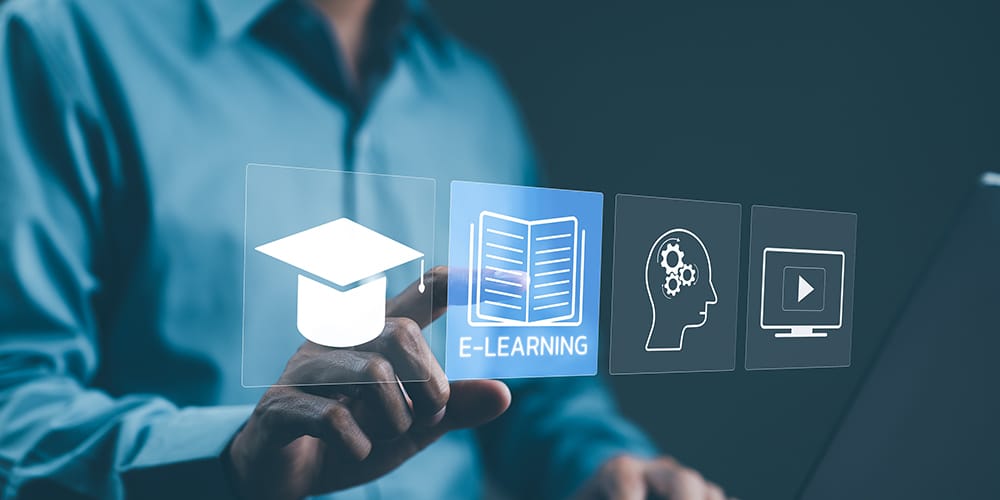The modern workforce thrives on collaboration and knowledge sharing. In this dynamic environment, Learning Experience Platforms (LXPs) are rapidly replacing traditional LMS (Learning Management Systems) as the go-to solution for employee development. However, simply deploying an LXP isn’t enough. To truly unlock its potential, organizations must leverage the power of social learning.
Social learning taps into peer-to-peer knowledge sharing, collaboration, and real-time feedback, creating a dynamic learning environment where employees learn from each other and apply new skills more effectively.
This comprehensive guide will provide you with the best practices for implementing social learning in LXPs and help answer some key questions like: What is an LXP? Why is it important to measure the ROI of a training program? How can AI revolutionize your L&D strategy?
Understanding Social Learning and Its Importance in LXPs
Social learning is a collaborative process where individuals learn from one another through observation, imitation, and interaction. This concept, rooted in Bandura’s Social Learning Theory, emphasizes the importance of peer-based learning. In the digital era, LXPs provide a platform for employees to engage with each other, share knowledge, and apply new skills in real-time.
LXPs, in contrast to traditional Learning Management Systems (LMS), focus on creating learner-centric experiences. While LMSs tend to emphasize formal, structured courses, LXPs prioritize engagement and knowledge sharing, allowing users to learn from each other as much as from the platform’s content.
This raises a common question for many organizations:
Which is better for my organization, LMS or LXP?
While an LMS may work well for compliance and formal training, a custom LXP for corporates enable social learning and a more dynamic, continuous learning environment. The right choice depends on your organization’s needs, but many companies are shifting toward LXPs to drive engagement and collaboration.
Key Questions to Consider:
- Are you currently using an LMS, and could your employees benefit from more collaborative, interactive learning experiences?
- How can social learning in your LXP enhance employee engagement and knowledge retention?
Key Features to Look for in an LXP for Effective Social Learning
To maximize the impact of social learning, you need an LXP with features that promote peer-to-peer interaction, collaboration, and knowledge sharing. Here are some of the most important features to look for:
- Social Interaction Tools: These include forums, discussion boards, and real-time chat features. Such tools encourage employees to share insights and collaborate on projects, enabling rich, peer-based learning experiences.
- User-Generated Content: An LXP should support user-generated content, allowing employees to create and share their own videos, presentations, and articles. This feature democratizes learning and ensures diverse perspectives within your workforce.
- Community Engagement: Look for an LXP that fosters communities of practice where employees can connect over shared interests or skills. This builds a sense of belonging and encourages deeper learning through discussion and collaboration.
- Mobile Accessibility: In today’s mobile-driven world, learning shouldn’t be confined to desktops. A mobile-friendly platform allows employees to engage in learning from anywhere, increasing flexibility and participation.
According to a 2023 report from Deloitte, organizations that adopt LXPs with social learning features experience a 40% improvement in employee engagement compared to those that don’t incorporate social learning into their training programs.
Key Questions to Consider:
- Does your current platform support these critical features?
- How important is mobile learning for your workforce, and are they able to access learning on the go?
Strategies to Foster a Culture of Social Learning Within Your Organization
To truly succeed with social learning, your organization must build a culture that values and encourages peer-based knowledge sharing. Here’s how to do that:
- Promote Collaboration: Foster a collaborative environment where employees can easily share knowledge and work together. This could include project-based learning groups or online communities centered on specific skills or interests.
- Encourage Knowledge Sharing: Recognize and reward employees who actively participate in discussions, share insights, or create content. This not only incentivizes engagement but also nurtures a culture of continuous learning.
- Leadership Involvement: Leaders should actively participate in the LXP and model collaborative learning behaviors. When executives share knowledge and engage in social learning, it sets the tone for the rest of the organization.
- Create Communities of Practice: These communities allow employees with similar interests or roles to come together, share insights, and problem-solve collaboratively. Encouraging employees to contribute to these communities helps build stronger internal networks and foster expertise.
Why is it important to measure the ROI of a training program?
Measuring ROI is essential for understanding the effectiveness of your L&D investments. A well-implemented social learning strategy should not only improve engagement but also drive business outcomes such as improved performance, innovation, and retention.
Key Questions to Consider:
- What incentives do you currently offer for knowledge sharing, and how can you further encourage it?
- Are your leaders active participants in social learning, and are they promoting a collaborative learning culture?
Best Practices for Designing Engaging Social Learning Experiences in LXPs
Designing engaging social learning experiences requires intentional planning. Here are a few best practices:
- Use Interactive Elements: Incorporate polls, quizzes, and peer reviews to make learning interactive and encourage employees to engage with one another. Interactive elements create a more immersive experience and increase retention.
- Incorporate Real-World Scenarios: By using real-world examples and scenarios, you help learners apply theoretical knowledge to practical situations, promoting deeper understanding and learning.
- Peer Feedback: Encourage peer feedback and review processes, allowing employees to evaluate each other’s work. This not only helps build a collaborative environment but also enhances the quality of learning.
According to a study by Gartner, organizations that emphasize peer-based learning through LXPs report a 35% increase in knowledge retention and a significant improvement in learner satisfaction.
Measuring the Impact of Social Learning on Employee Performance and Engagement
The success of your social learning strategy can’t just be anecdotal—it needs to be measured. Learning analytics tools can help track participation, engagement, and performance improvements.
Key Metrics to Measure:
- Engagement Levels: Track how often employees participate in discussions, create content, and interact with peers.
- Performance Metrics: Measure improvements in employee performance post-training. Are they applying what they’ve learned in their daily tasks?
- Feedback: Collect regular feedback from employees to understand their experience with the platform and identify areas for improvement.
Research from McKinsey shows that companies investing in collaborative learning technologies are twice as likely to innovate than those relying solely on formal training methods.
How can AI revolutionize your L&D strategy?
AI-powered tools in LXPs can personalize learning experiences, analyze engagement data to identify skill gaps, and even recommend peer-based learning resources based on employee needs, creating a tailored approach to professional development.
Key Questions to Consider:
- What data points are you using to measure the success of your social learning strategy?
- How can you leverage AI to better understand and enhance the learning experience?
Tackling Common Challenges When Implementing Social Learning in LXPs
While social learning offers significant benefits, there are challenges in implementation, including:
- Resistance to Change: Employees may be reluctant to engage in new learning formats. Overcome this by offering clear training on the platform’s benefits and making it user-friendly.
- Technology Adoption: Ensure the LXP is accessible, easy to use, and provides robust technical support. A poor user experience can hinder adoption and success.
- Inclusivity: Not all employees may feel comfortable participating in discussions. Create multiple channels for engagement and offer training on how to participate inclusively.
If you’re looking for comprehensive learning solutions that support social learning and go beyond traditional training methods, explore Integra’s Learning Products. Designed to foster peer-to-peer interaction and community engagement, these solutions offer the tools your organization needs to implement a dynamic and effective social learning strategy. Take the first step toward transforming your learning experience today!
Discover more at Integra Learning Products and empower your organization with cutting-edge solutions for tomorrow’s workforce.



